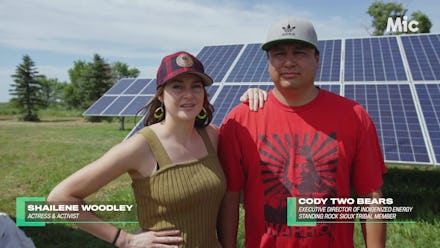How Native Americans at Standing Rock are fighting to protect their land from climate change

Three years after the Dakota Access Pipeline protests swept the nation at the Standing Rock Indian Reservation, Native American leaders have made history by opening the largest solar farm in the state of North Dakota on their tribal land.
The community solar farm project, led by the non-profit organization Indigenized Energy, will provide renewable energy on the Standing Rock reservation and is located just a few miles from the site of the Dakota Access Pipeline, which became operational in 2017 despite the widespread protests against its construction.
Cody Two Bears, founder and executive director of Indigenized Energy, told Mic in an exclusive video interview that the solar farm is projected to save up to $10,000 in energy costs annually and will also create local jobs. The 1100 solar panels are currently powering a community center in nearby Cannonball.
The project was unveiled in late July at a celebratory gathering on the reservation that brought together indigenous leaders, activists, philanthropists, politicians and celebrities from across the country, including actresses Shailene Woodley and Frances Fisher, former NBA star Joakim Noah, and Hawaii congresswoman and presidential candidate Tulsi Gabbard.
During the event, Two Bears told the audience, “Our goal is to be able to use our wisdom that was passed on from our ancestors and collaborate with new technologies of today. Can you imagine what kind of sustainable life we could have for our future?”
Woodley, one of the first celebrities to speak out against the construction of the Dakota Access Pipeline in 2016, told Mic that the movement against the pipeline served as the spark for the solar farm to be created. “When the #NoDAPL movement took off, the focus was on the pipeline, but the beauty of what actually occurred is that tens of thousands of people who were never in alignment or alliance with one another came together in a unified way,” she said. “The seeds that were planted there, this is one sprout of those seeds.”
“When you take into context how these indigenous people have been disrespected, mistreated, to take all of that hardship and turn it into something so positive, that’s what we’re seeing here today,” Gabbard told Mic.
The solar farm was supported by donations from the non-profit organizations Give Power and Empowered by light, along with a philanthropic grant from the Wallace Global Fund. The project is particularly notable because North Dakota currently ranks last in solar farm production nationwide and is one of the leading oil producing states in the country.
Tokata Iron Eyes, a youth activist and Indigenized Energy board member told Mic, “It’s such a breath of fresh air to see that something good can come out of [the pipeline protests]. It created the spark of change.”
Watch the video below and learn more about Indigenized Energy here: